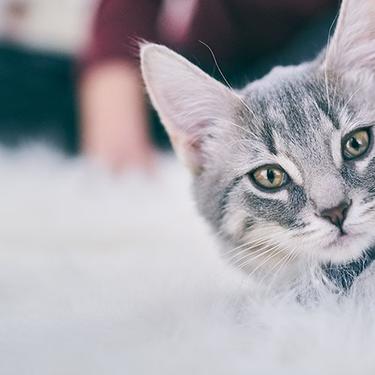
-
Find the right food for your pet
Take this quiz to see which food may be the best for your furry friend.
Find the right food for your pet
Take this quiz to see which food may be the best for your furry friend.
Featured products
 Adult 7+ Perfect Digestion Chicken, Whole Oats & Brown Rice Recipe Dog Food
Adult 7+ Perfect Digestion Chicken, Whole Oats & Brown Rice Recipe Dog FoodScience Diet's breakthrough nutrition supports ultimate digestive well-being & healthy microbiome for dogs age 7+
Shop Now Adult Healthy Cuisine Roasted Chicken, Carrots & Spinach Stew Dog Food
Adult Healthy Cuisine Roasted Chicken, Carrots & Spinach Stew Dog FoodDelicious roasted chicken paired with tender vegetables in a succulent stew
Shop Now Small & Mini Savory Stew with Chicken & Vegetables Dog Food
Small & Mini Savory Stew with Chicken & Vegetables Dog FoodA delicious complement to the nutrition of Science Diet Small & Mini 7+ dog food
Shop NowFeatured products
 Adult Savory Entrée Can Variety Pack Cat Food
Adult Savory Entrée Can Variety Pack Cat FoodPrecisely balanced nutrition with the delicious taste of savory minced chicken to help fuel the energy needs of cats during the prime of their life
Shop Now Adult 7+ Tender Tuna Dinner Cat Food
Adult 7+ Tender Tuna Dinner Cat FoodWith delicious chunks in a decadent gravy
Shop Now Adult 7+ Senior Vitality Chicken & Vegetable Stew Cat Food
Adult 7+ Senior Vitality Chicken & Vegetable Stew Cat FoodImproves Everyday Ability to Get Up & Go
Shop Now -
Dog
- Dog Tips & Articles
-
Health Category
- Weight
- Food & Environmental Sensitivities
- Urinary
- Digestive
- Joint
- Kidney
-
Life Stage
- Puppy Nutrition
- Adult Nutrition
- Senior Nutrition
Cat
- Cat Tips & Articles
-
Health Category
- Weight
- Skin & Food Sensitivities
- Urinary
- Digestive
- Kidney
-
Life Stage
- Kitten Nutrition
- Adult Nutrition
Featured articles
 Do Dogs and Cats have Belly Buttons?
Do Dogs and Cats have Belly Buttons?Learn whether cats & dogs have belly buttons like humans, what the function is, and if there are any health concerns associated with it.
Read More Does My Pet Hate Me?
Does My Pet Hate Me?Learn tips for bonding with your pet if you've ever thought, 'My dog doesn't like me, or 'Why do I have a standoffish cat?'
Read More Why Are Dogs and Cats So Cute?
Why Are Dogs and Cats So Cute?If waggy puppy dog tails and furry kitten yawns make you swoon, you're not alone. Why are cats so cute? And, dogs too! Let's find out!
Read More -


Breast cancer is ranked as the number one most heavily funded area of cancer research in people, according to Cancer.org, yet cat breast cancer has failed to gather much attention in the world of feline health. Despite this common tumor being such an uncommon topic, as noted by Merck Veterinary Manual, around 90% of mammary tumors in cats are malignant. Much like breast cancer in people, breast cancer in cats is prone to spreading to the patient's lungs and lymph nodes. Read up on this dangerous cancer in cats.
Clinical Signs of Cat Breast Cancer
The most commonly observed physical clue pointing toward breast cancer in cats is indeed a growing mass along the breast tissue chain on the cat's chest and abdomen. Masses may be isolated, all located on one side or seem to be randomly distributed. Unfortunately, by the time many pet parents notice it, the cancer may have spread to internal organs. Beyond lumps or swollen tissue, breast cancer in cats can also appear as:

- Skin rash on the breast tissue
- Reddened, painful skin
- Swollen tissue that may be bleeding or seeping discharge
- Ulcerated tissue
- Black and necrotic tissue
While we don't fully understand why some cats develop breast cancer and others do not, we do know that hormones contribute significantly to the development of mammary tumors in cats. This is why most veterinarians recommend spaying your cat before their first heat cycle. Some cats are believed to have a greater susceptibility to cancers due to genetics.
Cat Breast Cancer Risk Factors
Because hormones play a role in the development of breast tumors, the more a cat is exposed to those hormones, the higher their chances are of developing them. This puts middle-aged to older animals at the highest risk to develop cat breast cancer, though breast tumors can occur in younger cats, as well.
While no breed is immune, vets see much more breast cancer in Siamese and Persian cats, as compared to domestic short-haired cats. Mammary tumors are rare in male cats, but do occur, contrary to popular belief.
Diagnosing Cat Breast Cancer
Dr. Margaret McEntee, a professor of Veterinary Oncology at Cornell University's College of Veterinary Medicine, explains, "a cat has two 'chains' of four mammary glands and nipples running parallel on each side of its belly." It is along this mammary chain that breast cancer is found in the cat. The tumor often starts so small it is easily missed by even the most attentive pet parents. The mass is most often located just beneath or next to one of the nipples, though anywhere along the breast chain or incorporated surrounding tissue is possible.
To move forward with a diagnosis, your vet may recommend two outpatient diagnostic tests: radiographs (X‑rays) and tissue samples (biopsies). These allow the vet to avoid confusing mammary tumors with non-dangerous overgrowth of mammary tissue, called mammary hypertrophy. While nursing, cats may also develop swollen breast tissue for other reasons, including mastitis, an infection of the breast tissue, or a clogged milk duct. If you see any abnormal swelling, its best to contact your veterinarian.


Tasty Tips
Prognosis of Cat Breast Cancer
Breast tumors in cats are staged to help your vet estimate your cat's prognosis, as well as determine the best treatment. A simplified look at staging involves tumor size and regional and distant spread.

Tumor size is the single most important prognostic factor, as explained by experts at The Ohio State University Veterinary Medical Center. Cats with larger tumors have the shortest survival time (around four to six months), while cats with tumors smaller than a 2 cm diameter have a median survival time of over three years.
Evaluating regional lymph nodes is useful in telling the vet if the tumor has spread locally. While you can't evaluate every cell of the lymph node, if your vet notices a change in size of lymph nodes, that's generally a good sign. Lymph node size increase is usually an exaggerated change, and not the typical subtle increase in size because of mammary adenocarcinoma, the most commonly diagnosed breast tumor in cats.
Distant metastasis is the final category your vet will use to evaluate the tumor and your cat's prognosis. In order to gauge if distant metastasis has occurred, your vet will evaluate the lungs by reviewing chest radiographs (X-rays). The lungs are a common site for distant spread.
Treatment and Prevention of Cat Breast Cancer
According to The Ohio State University Veterinary Medical Center, surgery is the go-to choice for mammary tumors in cats. Radical mastectomy, which is the removal of all glands on the affected mammary chain side, significantly reduces the chance that the tumor will come back. Your vet or a veterinary oncologist will work with you to determine the best surgery for your cat.
Chemotherapy is also often used alongside surgery. Cats generally experience fewer and less severe side effects from chemotherapy than humans because a gentler dose and less intense schedule is typically used in cats. While cats may sometimes experience an upset stomach from chemotherapy, they usually do not experience hair loss like people do.
While cat breast cancer is a real threat to felines of all ages, breeds and even genders, the great news is that spaying your cat at a young age is an easy and effective method of prevention. Spaying your cat before the first heat cycle is ideal, as it provides the greatest protection against the effects of hormones. Talk to your vet about the best course of treatment for your favorite furry friend.


Dr. Laci Schaible is a small animal veterinarian, veterinary journalist, and a thought leader in the industry. She received her Doctor of Veterinary Medicine from Texas A&M University and her Masters in Legal Studies from Wake Forest University.
Related products

With delicious chunks in a decadent gravy

Improves Everyday Ability to Get Up & Go

Supports energy level and beautiful fur in mature cats

Precisely balanced nutrition with the delicious taste of savory minced chicken to help fuel the energy needs of cats during the prime of their life
Related articles

Discover the benefits of Hill's line of kitten foods and how they provide complete and balance nutrition for growing kittens.

Discover how to identify cat sensitive skin and what you can do to help your cat thrive from head to paw.

Discover which cat toys games your feline friend might like, and how they are great sources of exercise. Explore our library of articles to learn more.

Brushing your cat's teeth is just as important as brushing your own. Learn signs or oral health problems in your cat and how to avoid them.

Put your cat on a diet without them knowing
Our low calorie formula helps you control your cat's weight. It's packed with high-quality protein for building lean muscles, and made with purposeful ingredients for a flavorful, nutritious meal. Clinically proven antioxidants, Vitamin C+E, help promote a healthy immune system.
Put your cat on a diet without them knowing
Our low calorie formula helps you control your cat's weight. It's packed with high-quality protein for building lean muscles, and made with purposeful ingredients for a flavorful, nutritious meal. Clinically proven antioxidants, Vitamin C+E, help promote a healthy immune system.

